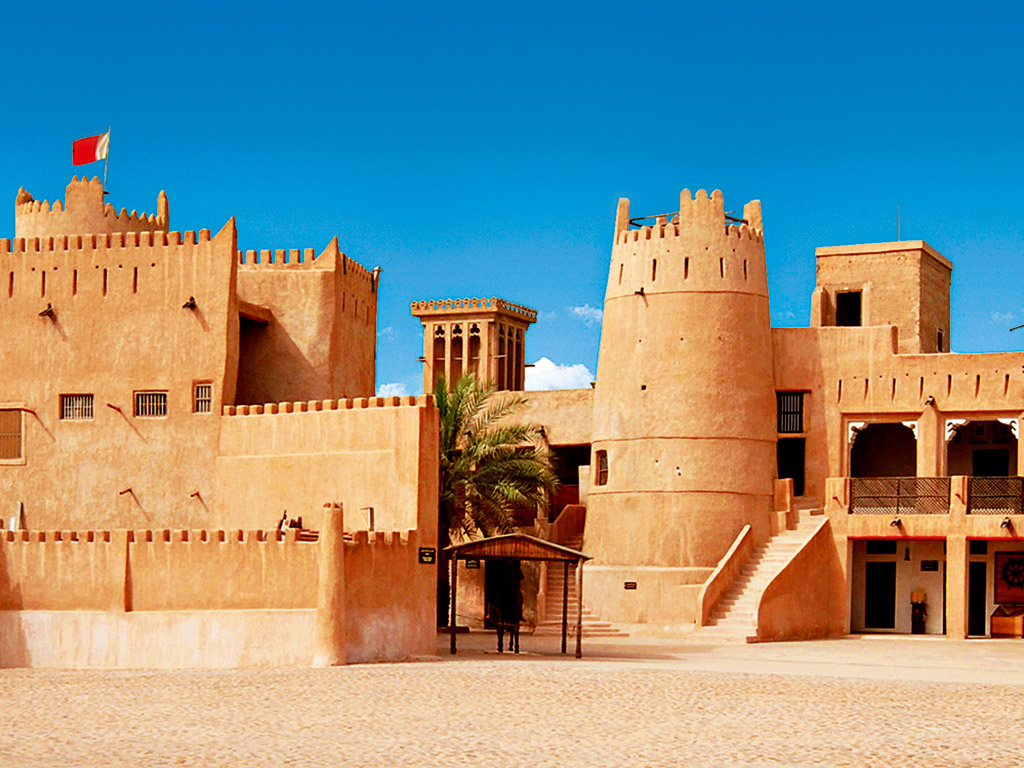Located on the Arabian Gulf coast, Ajman is the smallest of the UAE emirates. Three diverse cities dominate Ajman’s cultural and business offerings – the capital, Ajman, and the smaller cities of Masfout and Al Manama. With historic forts, intriguing museums and rich equestrian heritage, Ajman is deservedly Business Destinations’ Best Destination for Cultural Tourism, Middle East, 2014.
Ajman is extremely proud of its equestrian heritage, and visitors are invited to saddle up at the Ajman Equestrian Club
Escape to Masfout
Less than two hours away from the centre of the capital is the tiny Ajman enclave of Masfout. Taking the Dubai-Hatta Road will involve a couple of checkpoints as it passes through an Oman outpost, so take your passport with you – alternatively use the Sharjah-Kalba Road. Both routes pass fantastic rolling dunes before reaching the peaceful foothills of the Hajar Mountains. They are a hiker’s dream and a refreshing escape from the city heat.
Masfout is a summer retreat for residents of Ajman city. Its elevated altitude and distance from the city offer cooler climes and a fresh breeze, making it a welcome escape from the oppressive heat of the warmer months. Human activity in the area has been traced back more than 5,000 years thanks to archaeological finds, including an ancient rock carving – a depiction of which is at Ajman Museum.
The rocky countryside surrounding the town is ideal for walking, mountain biking, picnics and wadi exploration. The landscape hides resilient flora and fauna and was once home to a menagerie that includes leopards, gazelles and foxes. There are plans to attract more visitors to Masfout’s beautiful natural surroundings with the development of hotels and parks.
The stretch of road running past the outskirts of Masfout is lined with roadside pottery vendors, selling traditional pots of all sizes. Arabian Pottery, on the right as you head back towards Ajman on the Dubai-Hatta Road, has a lovely garden displaying its various wares. There are some well-stocked grocery stores in the town for picking up water and snacks before exploring the surrounding mountains, and the Holiday Arabian Resort.
Masfout Castle lies at the top of the mountains on the northern borders of Masfout. Built in the nineteenth century, the castle consists of two rooms and a gate. When late Sheikh Rashid Bin Humaid Al Nuaimi became ruler in 1947, he renovated the building. At that time the castle was used to protect the area from bandits heading to the Sultanate of Oman.
The late Sheikh Rashid Bin Humaid Al Nuaimi built Masfout Gate in 1961. As guests enter the city the gate greets them with a positive message: “Arrivals are welcome”. Meanwhile, those who go out read: “Goodbye”.
Al Manama
The Al Manama museum is housed within a fort, built at the time of the late Sheikh Rashid bin Humaid Al Nuaimi, and features a yard overlooking seven large rooms. The fort is surrounded by palm trees, which are irrigated by the old Al Manama falaj (man-made water channels) that flow down from the mountains.
Based on His Highness Sheikh Humaid bin Rashid Al Nuaimi, Ruler of Ajman and Member of the UAE Supreme Council, instructions, Al Maerre fort officially became Al Manama museum on December 2, 2012.
The Hassa Buweid castle represents another legacy in the historical heritage of the Emirate of Ajman. Built by the late Sheikh Rashid bin Humaid Al Nuaimi in 1976, on top of a gravel and stone hill, it was named Hassa Buweid in reference to its white stones. The castle’s main purpose was to provide protection.
Also in the area is the Red Fort, built during the time of Sheikh Humaid bin Abdul Aziz Al Nuaimi, which consists of four rooms and two towers. In 1986, following instructions from HH Sheikh Humaid bin Rashid Al Nuaimi, a complete restoration of the fort was carried out and a third tower joined the two older ones. Gravel and red plaster were used in the construction of the walls of the fort, earning its name. The fort is completely surrounded by trees, while a picturesque well close to the building provides drinking water.
A natural area, currently under development in the Al Manama area, Al Naseem Nature Reserve will showcase the beauty of the region’s natural landscape while protecting its rarest flora and fauna. When completed, the nature reserve will feature a number of natural parks, a nursery for plants, and an education centre for students, biologists and others interested in the Ajman landscape.
Back in the capital
Unsurprisingly, Ajman is extremely proud of its equestrian heritage, and visitors are invited to saddle up at the Ajman Equestrian Club. It houses more than 100 well-trained Arabian horses and offers a range of lessons and riding activities. Expert trainers are on hand to offer instruction in a number of languages, and even total beginners can try their hand at the sport and rent the necessary livery on site.
Both group and private lessons are available, costing between Dhs40 and Dhs100, and for advanced riders there are courses in show jumping and dressage. It is the perfect way to stay active in the sun.
Horse lovers will also appreciate the Ajman Arabian Horse Stud Farm, owned by HH Sheikh Ammar bin Humaid Al Nuaimi, Crown Prince of Ajman, which is home to some of the finest Arabian horses in the world.
The capital also boasts an exciting museum. First established as Ajman Fort, it is one of the main historical attractions in the UAE. Over the years it has shown visitors the reality of UAE life in different eras. This fort was the stronghold of the emirate’s leadership, representing the political authority here, and the first line of its defence. This historical landmark stands tall as a record of the exploits of ancestors, and thanks to a generous gesture from HH Sheikh Humaid bin Rashid Al Nuaimi, Supreme Council Member and Ruler of Ajman, this fort has been gifted to the people of the UAE through its conversion into a fully fledged museum. Visitors will find antiquities, traditional industries and artifacts, as well as sections portraying the way of life in the past.
Located on the Ajman Corniche, Al-Murabaa Watchtower is one of the most important tourist attractions in the emirate. It was built in the 1930s on the orders of late Sheikh Rashid Bin Humaid Al Nuaimi (1982-1981), the then ruler of Ajman, to provide security for residents. It was rehabilitated in 2000 upon directives from His Highness Sheikh Humaid Bin Rashid Al-Nuaimi.
Much of the activity in Ajman is concentrated along the Corniche and its attractive 16km stretch of beach overlooking the Arabian Gulf. The Corniche boasts a wide variety of shopping options, including souks, markets and malls, both traditional and fast food restaurants, as well as cafes and shops.
Al Zorah Nature Reserve has a seven km waterfront, embracing the changing shades of the Arabian Gulf Sea and a two km silky sand beach. Al Zorah lets guests discover Ajman’s natural wonders: translucent lagoons, creeks and an inviting mangrove forest, swarming with 58 bird species. Highest priority is given to the management and preservation of Ajman’s coastal treasure: the mangrove forest. Extending over two sq km of biologically and ecologically rich wetland, the mangrove area is also the first nursery on the coast. By contemplating the Al Zorah coastline, nature lovers will get to discover many species, including the emblematic pink flamingo. Native and migratory birds inhabit the marine zones, turquoise lagoons, mangrove and dunes areas.
Located at Sheikh Zayed Street in Al Helio district, Helio Park is an outdoor attraction on the outskirts of Ajman. Thursdays, Fridays and Saturdays are family days, when it is open to men as well as women and children. Much of the park is geared towards keeping active, including its basketball courts, football area, and outdoor gym equipment. There are pedal go-karts for hire, as well as a dedicated go-kart track. Food-wise, there are a few stalls to choose from, but a better option is the public barbecue area, where you can create a picnic of your own. Plenty of shaded tables make for comfortable, al fresco dining.







